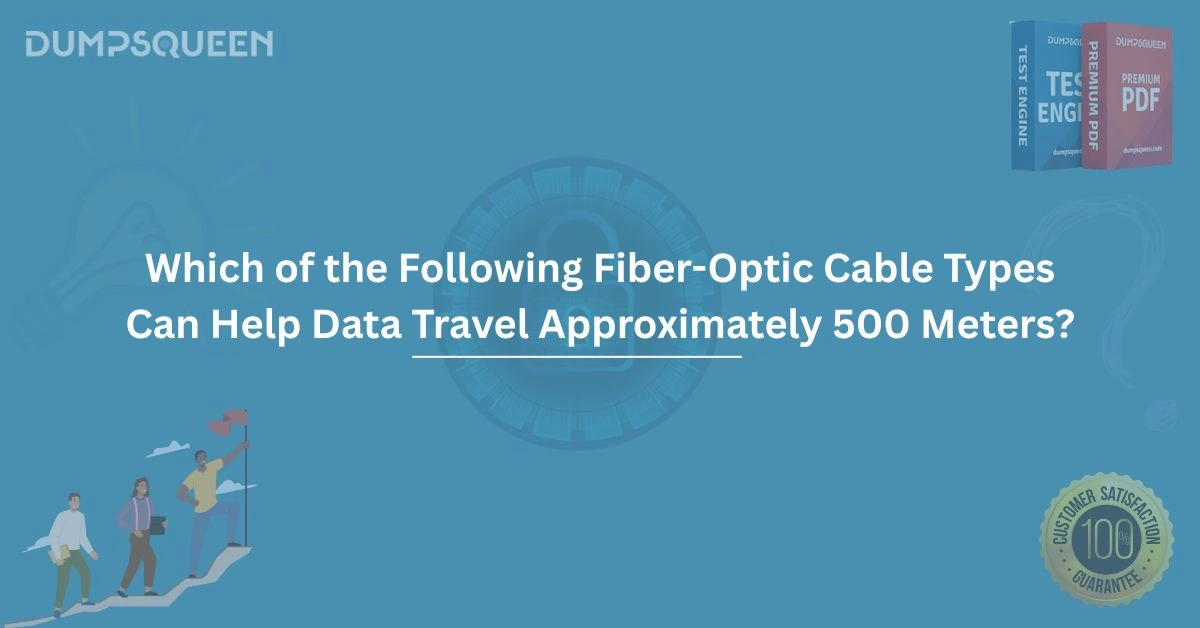Introduction
In the rapidly evolving world of telecommunications and networking, fiber-optic cables have become the backbone of high-speed data transmission. These cables, which transmit data as pulses of light through strands of glass or plastic, offer unparalleled speed, reliability, and bandwidth compared to traditional copper cables. However, not all fiber-optic cables are created equal. When it comes to transmitting data over specific distances, such as approximately 500 meters, choosing the right cable type is critical for ensuring optimal performance. This comprehensive guide, brought to you by DumpsQueen, explores the various fiber-optic cable types and identifies which ones are best suited for data transmission over 500 meters. Whether you're preparing for a certification exam or seeking to enhance your networking knowledge, DumpsQueen is your trusted resource for professional insights and exam preparation materials.
The Basics of Fiber-Optic Cables
Fiber-optic cables are designed to carry data over long distances with minimal signal loss, making them ideal for applications ranging from internet connectivity to enterprise networking. These cables consist of a core, which carries the light signals, surrounded by a cladding layer that reflects the light back into the core, preventing signal loss. A protective outer jacket shields the cable from environmental damage. Fiber-optic cables are broadly categorized into two types: single-mode and multimode. Each type has distinct characteristics that determine its suitability for specific distances and applications.
Single-mode fiber (SMF) features a smaller core diameter, typically around 8-10 microns, allowing only one mode of light to propagate. This results in lower signal attenuation and higher bandwidth over long distances. Multimode fiber (MMF), on the other hand, has a larger core diameter, usually 50 or 62.5 microns, which allows multiple light modes to travel simultaneously. While this increases bandwidth for short distances, it also leads to higher signal dispersion, limiting its effective range.
Understanding these fundamental differences is crucial when selecting a fiber-optic cable for a 500-meter data transmission, as the choice depends on factors such as distance, bandwidth requirements, and cost.
Why Distance Matters in Fiber-Optic Cable Selection
Distance is a critical factor in determining the appropriate fiber-optic cable for a network. The farther data needs to travel, the more important it becomes to minimize signal loss and dispersion. For a distance of approximately 500 meters, both single-mode and multimode fibers can be considered, but their performance varies significantly.
Multimode fibers are typically used for shorter distances due to their larger core size, which allows more light to enter but also increases modal dispersion. This dispersion causes the light pulses to spread out, reducing signal clarity over longer distances. Single-mode fibers, with their smaller core, experience less dispersion and are better suited for longer distances. However, single-mode systems are often more expensive due to the precision required in their manufacturing and the cost of compatible transceivers.
For a 500-meter transmission, the choice between single-mode and multimode fiber depends on the specific cable subtype, the wavelength of light used, and the network's performance requirements. Let’s delve into the specific fiber-optic cable types to determine which ones are suitable for this distance.
Multimode Fiber-Optic Cables for 500 Meters
Multimode fiber-optic cables are commonly used in local area networks (LANs), data centers, and campus networks due to their cost-effectiveness and compatibility with short- to medium-range applications. Multimode fibers are further classified into different categories, known as Optical Multimode (OM) standards, each with distinct performance characteristics. The most relevant categories for a 500-meter transmission are OM2, OM3, and OM4.
OM2 Multimode Fiber
OM2 multimode fiber has a core diameter of 50 microns and is designed for use with LED-based light sources. It operates at a wavelength of 850 nm and supports data rates up to 1 Gbps over distances of approximately 550 meters. While OM2 can technically support a 500-meter transmission for Gigabit Ethernet, its performance is limited compared to newer standards. The use of LEDs as a light source results in higher dispersion, which can degrade signal quality over longer distances. For modern networks requiring higher bandwidth, OM2 is often considered outdated.
OM3 Multimode Fiber
OM3 multimode fiber, also known as laser-optimized multimode fiber, is designed for use with vertical-cavity surface-emitting lasers (VCSELs). VCSELs produce a more focused light beam, reducing dispersion and enabling higher data rates. OM3 has a 50-micron core and operates at 850 nm, supporting 10 Gigabit Ethernet (10GbE) over distances up to 300 meters. However, with specific transceivers and configurations, OM3 can achieve 1 Gbps over 550 meters, making it a viable option for a 500-meter transmission in certain scenarios. OM3 is widely used in enterprise networks due to its balance of performance and cost.
OM4 Multimode Fiber
OM4 is an enhanced version of OM3, offering improved performance for longer distances and higher data rates. Like OM3, OM4 has a 50-micron core and is optimized for VCSELs at 850 nm. It supports 10GbE over distances up to 400 meters and, with optimized transceivers, can achieve 1 Gbps over 1000 meters. For a 500-meter transmission, OM4 is a strong candidate, as it provides greater flexibility and future-proofing for networks planning to upgrade to higher speeds. OM4 is increasingly popular in data centers and campus networks where medium-range connectivity is required.
Limitations of Multimode Fiber
While OM2, OM3, and OM4 multimode fibers can support a 500-meter transmission under certain conditions, their performance is heavily influenced by the choice of transceivers, light sources, and network equipment. Multimode fibers are generally more cost-effective than single-mode fibers, but their effective range is limited by modal dispersion. For applications requiring consistent performance over 500 meters or beyond, single-mode fiber may be a better choice.
Single-Mode Fiber-Optic Cables for 500 Meters
Single-mode fiber-optic cables are designed for long-distance, high-bandwidth applications, making them ideal for telecommunications, metropolitan area networks (MANs), and wide area networks (WANs). Unlike multimode fibers, single-mode fibers have a small core diameter that allows only one light mode to propagate, resulting in minimal dispersion and signal loss.
OS1 and OS2 Single-Mode Fiber
Single-mode fibers are categorized into two main types: OS1 and OS2. OS1 is designed for indoor or controlled environments and operates at wavelengths of 1310 nm or 1550 nm. It supports data rates up to 10 Gbps over distances of several kilometers, far exceeding the 500-meter requirement. OS2, designed for outdoor and long-haul applications, offers even lower attenuation and can transmit data over tens of kilometers. Both OS1 and OS2 are suitable for a 500-meter transmission, providing high reliability and scalability.
Advantages of Single-Mode Fiber
For a 500-meter transmission, single-mode fiber offers several advantages over multimode fiber. Its low attenuation and minimal dispersion ensure that the signal remains strong and clear, even over longer distances. Single-mode fiber also supports higher data rates, making it a future-proof choice for networks anticipating growth. However, single-mode systems require more expensive transceivers and connectors, which can increase the overall cost of deployment.
When to Choose Single-Mode Fiber
Single-mode fiber is the preferred choice for a 500-meter transmission when the network requires high bandwidth, long-term scalability, or the potential for future expansion. For example, in a campus network connecting multiple buildings, single-mode fiber can provide reliable connectivity over 500 meters while accommodating future upgrades to 40GbE or 100GbE. DumpsQueen recommends single-mode fiber for professionals seeking to build robust, high-performance networks.
Comparing Multimode and Single-Mode for 500 Meters
To determine the best fiber-optic cable for a 500-meter data transmission, it’s essential to compare the performance, cost, and application suitability of multimode and single-mode fibers.
Performance
Multimode fibers, particularly OM3 and OM4, can support a 500-meter transmission for 1 Gbps Ethernet, with OM4 offering additional headroom for 10GbE over shorter distances. However, their performance is limited by modal dispersion, which can impact signal quality. Single-mode fibers (OS1 and OS2) provide superior performance, with minimal signal loss and the ability to support multi-gigabit speeds over much longer distances.
Cost
Multimode fiber systems are generally more cost-effective due to the lower cost of transceivers and connectors. OM3 and OM4 are particularly attractive for budget-conscious deployments. Single-mode fiber systems, while more expensive upfront, offer long-term savings for networks requiring scalability or extended reach.
Application Suitability
For short- to medium-range applications, such as within a data center or campus network, multimode fibers like OM3 and OM4 are often sufficient for 500 meters. Single-mode fibers are better suited for applications requiring long-distance connectivity, high bandwidth, or future-proofing. DumpsQueen advises network professionals to assess their specific requirements, including budget, performance goals, and growth plans, before making a decision.
Practical Considerations for Deployment
When deploying fiber-optic cables for a 500-meter transmission, several practical considerations come into play. First, ensure that the cable is properly installed to avoid bending or damage, which can degrade performance. Use appropriate connectors and transceivers compatible with the chosen fiber type. For multimode fibers, VCSEL-based transceivers are recommended for OM3 and OM4, while single-mode fibers require precision connectors like LC or SC.
Additionally, consider the environmental conditions. For outdoor deployments, OS2 single-mode fiber with robust jacketing is ideal for withstanding harsh weather. For indoor applications, OM3 or OM4 multimode fiber may suffice. Finally, test the network after installation to verify signal strength and performance. DumpsQueen offers resources and practice exams to help professionals master these deployment techniques.
Conclusion
Selecting the right fiber-optic cable for a 500-meter data transmission requires a thorough understanding of the differences between multimode and single-mode fibers, as well as their respective subtypes. Multimode fibers like OM3 and OM4 are cost-effective options for medium-range applications, while single-mode fibers like OS1 and OS2 offer superior performance and scalability for long-term deployments. By carefully evaluating performance, cost, and application requirements, network professionals can make informed decisions to ensure reliable connectivity.
DumpsQueen is committed to empowering IT professionals with the knowledge and tools needed to excel in networking certifications and real-world applications. Whether you're studying for an exam or designing a network, our expertly crafted resources, including practice questions and detailed guides, are here to support your success. Visit the DumpsQueen for more insights and exam preparation materials to advance your career in networking.
Free Sample Questions
Question 1: Which of the following fiber-optic cable types can support a 500-meter data transmission at 1 Gbps?
A) OM1
B) OM3
C) OS1
D) Both B and C
Answer: D) Both B and C
Question 2: What is the primary advantage of using single-mode fiber over multimode fiber for a 500-meter transmission?
A) Lower cost
B) Higher modal dispersion
C) Minimal signal loss
D) Compatibility with LED light sources
Answer: C) Minimal signal loss
Question 3: Which multimode fiber type is optimized for 10GbE over distances up to 400 meters?
A) OM2
B) OM3
C) OM4
D) OM1
Answer: C) OM4
Question 4: For a 500-meter transmission in a campus network, which fiber-optic cable type offers the best future-proofing?
A) OM2
B) OS2
C) OM1
D) OM3
Answer: B) OS2



